Theory of Computation questions and answers
(1) From the options given below, the pair having different expressive power is(A) Deterministic Push Down Automata (DPDA) and Non-deterministic Push Down Automata (NPDA)
(B) Deterministic Finite Automata (DFA) and Non-deterministic Finite Automata(NFA)
(C) Single tape turning machine and multi tape turning machine.
(D) Deterministic single tape turning machine and Non-Deterministic single tape turning machine
View Answer / Hide AnswerANSWER: Deterministic Push Down Automata (DPDA) and Non-deterministic Push Down Automata (NPDA)
(A) Finiteness problem for FSA’s
(B) Membership problem for CFG’s
(C) Equivalence problem for FSA’s
(D) Ambiguity problem for CFG’s
View Answer / Hide AnswerANSWER: Ambiguity problem for CFG’s
(A) Strings that begin and end with the same symbol
(B) All odd and even length palindromes
(C) All odd length palindromes
(D) All even length palindromes
View Answer / Hide AnswerANSWER: All odd length palindromes
(A) π is NP-complete
(B) π is NP-hard but not NP-complete
(C) π is in NP but not NP-complete
(D) π is neither NP-hard nor in NP
View Answer / Hide Answer(5) Out of the three problems S, Q and R, S is an NP-complete problem and Q and R are the two other problems not known to be in NP. Which one of the following statements is true if Q is polynomial time reducible to S and S is the polynomial time reducible to R?(A) Q is NP-complete
(B) R is NP-complete
(C) Q is NP-hard
(D) R is NP-hard
View Answer / Hide Answer(6) From the options given below the statement, which is not necessarily true if X1 is the recursive language and X2 and X3 are the languages that is recursively enumerable but not recursive is(A) X2 ∩ X1 is recursively enumerable
(B) X2 ∪ X1 is recursively enumerable
(C) X2 – X1 is recursively enumerable
(D) X1 – X3 is recursively enumerable
View Answer / Hide AnswerANSWER: X1 – X3 is recursively enumerable
(A) It is not regular but context free
(B) It is regular but not context free
(C) It is neither regular nor context free, but accepted by a turing machine
(D) It is not accepted by turing machine
View Answer / Hide AnswerANSWER: It is neither regular nor context free, but accepted by a turing machine
(A) Infinite union of finite sets is regular
(B) The union of two non-regular set is not regular
(C) Every finite subset of a non-regular set is regular
(D) Every subset of a regular set is regular
View Answer / Hide AnswerANSWER: Every finite subset of a non-regular set is regular
(A) All strings containing at least two 1’s
(B) All strings containing at least two 0’s
(C) All strings that begin and end with either 0’s or 1’s
(D) All strings containing the substring 00
View Answer / Hide AnswerANSWER: All strings containing at least two 0’s
(A) NP-complete and in P respectively
(B) Undecidable and NP-complete
(C) Both NP-complete
(D) Both in P
View Answer / Hide AnswerANSWER: NP-complete and in P respectively
(A) The intersection of two context free languages is context free
(B) A context free language can always be accepted by a deterministic push down automaton
(C) The union of two context free languages is context free
(D) The complement of a context free language is context free.
View Answer / Hide AnswerANSWER: The union of two context free languages is context free
(A) 2k + 1
(B) k + 1
(C) 2n + 1
(D) n + 1
View Answer / Hide Answer(13) Consider a stack, which is limited to 10 items. The language accepted by a push- down automaton in such stack is best described as(A) Regular
(B) Deterministic context free
(C) Context free
(D) Recursive
View Answer / Hide Answer(14) Which one of the following statement is true if L denotes the language generated by the grammar S->0S0/00?(A) L is not context free
(B) L is regular but not 0+
(C) L = 0+
(D) L is context free but not regular
View Answer / Hide AnswerANSWER: L is regular but not 0+
(A) 0 + (0 + 10) *
(B) (0 +1) * 10 (0 + 1) *
(C) (1 * 0) * 1*
(D) None of the above
View Answer / Hide AnswerANSWER: None of the above
(A) n
(B) 2n
(C) n + 1
(D) n - 1
View Answer / Hide Answer(17) The DFA shown below accepts the set of all strings over {0, 1} that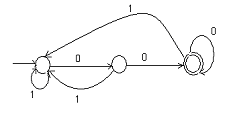
(A) End with 00
(B) End with 0
(C) Begin either with 0 or 1
(D) Contain the substring 00
View Answer / Hide Answer(18) We have two statements S1 and S2 whose definition are as follows: S1 – {0
2n In ≥ I} is a regular language.
S2 – {0
m 1
n 0 1
m+n Im=1 and n≥1I is a regular language.
Which one of the following statements is correct?
(A) Both S1 and S2 are correct
(B) Only S2 is correct
(C) Only S1 is correct
(D) Neither S1 nor S2 is correct
View Answer / Hide AnswerANSWER: Only S1 is correct
(A) L = {s ∈ (0+1)* I for every prefix s’ of s, I no(s’)-n1(s’) I ≤ 2}
(B) L = {s ∈ (0+1)* I no(s) mod 7 = n1(s) mod 5 = 0}
(C) L = {s ∈ (0+1)* I no(s) is a 3 digit prime}
(D) L = {s ∈ (0+1)* I no(s)-n1(s) I ≤ 4
View Answer / Hide AnswerANSWER: L = {s ∈ (0+1)* I no(s)-n1(s) I ≤ 4
(A) In Chomsky Normal Form the derivative trees of strings generated by a context-free grammar are always binary trees
(B) If W is the string of a terminals and Y is a non-terminal, the language generated by a context free grammar, all of whose productions are of the form x->W or X->WY is always regular
(C) By using suitable transformation all ε-productions can be removed from any context-free grammar.
(D) Every left recursive grammar can be converted to a right recursive grammar and vice-versa
View Answer / Hide AnswerANSWER: If W is the string of a terminals and Y is a non-terminal, the language generated by a context free grammar, all of whose productions are of the form x->W or X->WY is
always regular
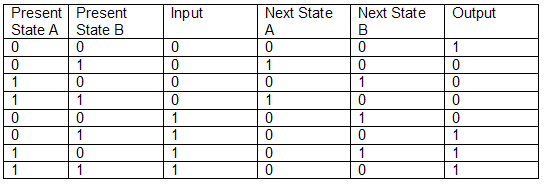
Let the initial state be A = 0 and B = 0. To take the machine to the state A = 0 and B = 1 with output = 1 the minimum length of input string required will be
(A) 2
(B) 7
(C) 4
(D) 3
View Answer / Hide Answer For questions 22 and 23 refer to the data given below:
The figure shown below is a finite state automaton
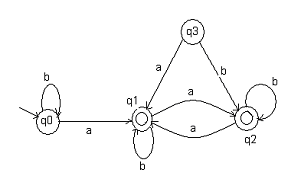 (22) Which one of the following is true for this automaton?
(22) Which one of the following is true for this automaton?(A) b*ab*ab*ab*
(B) b*a(a+b)*
(C) b*ab*ab*
(D) (a+b)*
View Answer / Hide Answer(23) For the above FSA the equivalent minimum state automaton has the following number of states(A) 1
(B) 2
(C) 3
(D) 4
View Answer / Hide Answer(24) Out of the three decision problems P1, P2 and P3, P1 is decidable and P2 is undecidable. The statement that holds true is(A) P3 is decidable if P3 is reducible to compliment of P2
(B) P3 is decidable if P1 is reducible to P3
(C) P3 is undecidable if P1 is reducible to P3
(D) P3 is undecidable if P2 is reducible to P3
View Answer / Hide AnswerANSWER: P3 is undecidable if P2 is reducible to P3
a. G is ambiguous
b. G produces all strings with equal number of a’s and b’s.
c. Deterministic PDA accepts G
Which of the following statement is true about G?
(A) a, b, c all are true
(B) Only and b are true
(C) Only b and c are true
(D) Only a is true
View Answer / Hide AnswerANSWER: a, b, c all are true
(A) 5
(B) 7
(C) 9
(D) 11
View Answer / Hide Answer(27) Consider the language L = {W I W ∈ {0, 1}*, where 0’s and 1’s in W are divisible by 3 and 5 respectively. The minimum state deterministic finite automaton accepting the language L has(A) 20 states
(B) 5 states
(C) 10 states
(D) 15 states
View Answer / Hide Answer(28) We have an undirected graph G(V, E) with two problems given below: α – Does G have an independent set of size IVI – 4?
β – Does G have an independent set of size 5?
The statement that holds true is
(A) α is NP-complete and β is in P
(B) α is in P and β is NP-complete
(C) Both α and β are NP-complete
(D) Both α and β are in P
View Answer / Hide AnswerANSWER: α is in P and β is NP-complete
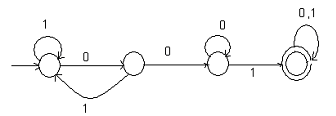
(A) 1
(B) 9
(C) 3
(D) 5
View Answer / Hide Answer(30) Which one of the following statement is true for a regular language L over {a} whose minimal finite state automation has two states?(A) L must be either {a
n I n is odd} or {a
n I n is even}
(B) L must be {a
n I n is odd}
(C) L must be {a
n I n is even}
(D) L must be {a
n I n = 0}
View Answer / Hide AnswerANSWER: L must be either {an I n is odd} or {an I n is even}
(A) Only DHAM3 is NP-hard
(B) Only SHAM3 is NP-hard
(C) Both SHAM3 and DHAM3 are NP-hard
(D) Neither SHAM3 nor DHAM3 is NP-hard
View Answer / Hide AnswerANSWER: Both SHAM3 and DHAM3 are NP-hard
(A) It is context-free but not regular
(B) It is regular
(C) It is type-0 but not context-sensitive
(D) It is context-sensitive but not context-free
View Answer / Hide Answer(33) We have decision problems P1 and P2 as described below: P1: Does a given finite state machine accept a given string?
P2: Does a given context-free grammar generate an infinite number of strings?
The statement that holds true for P1 and P2 is
(A) Only P2 is decidable
(B) Only P1 is decidable
(C) Neither P1 nor P2 are decidable
(D) Both P1 and P2 are decidable
View Answer / Hide AnswerANSWER: Both P1 and P2 are decidable
We have a turing machine M over the input alphabet ∑, any state q of M and a word W ∈ ∑*, does the computation of M on W visit the state q? The statement, which holds true
about X, is
(A) X is undecidable but partially decidable
(B) X is decidable
(C) X is not a decision problem
(D) X is undecidable and not even partially decidable.
View Answer / Hide AnswerANSWER: X is undecidable but partially decidable
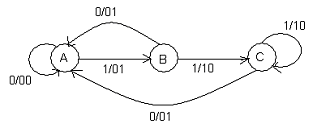
(A) Whenever the input sequence is 10 it outputs 00
(B) Whenever the input sequence is 11 it outputs 01
(C) It outputs the sum of the present and the previous bits of the input
(D) None of the above
View Answer / Hide AnswerANSWER: It outputs the sum of the present and the previous bits of the input
(A) It is a regular language
(B) It is context-sensitive language
(C) It is context-free language
(D) It is parsable fully only by a turing machine
View Answer / Hide AnswerANSWER: It is context-free language
(A) 5
(B) 4
(C) 3
(D) 2
View Answer / Hide Answer(38) The last two symbols of L which is the set of all binary strings are same. In the minimum state deterministic finite state automaton, which is accepting L _____, states are present(A) 4
(B) 6
(C) 3
(D) 5
View Answer / Hide Answer(39) The true regular expression is (A) (r*s*)* = (r+s)*
(B) (r+s)* = r* + s*
(C) r*s* = r* + s*
(D) r(*) = r*
View Answer / Hide Answer(40) Let n be the length of a character string. How many substrings (of all lengths inclusive) can be formed from n?(A) n(n-1)/2
(B) n
²(C) (n (n+1)/2) + 1
(D) n
View Answer / Hide Answer(41) The set which is not countable if we have ∑ = {a, b}, is(A) Set of all languages over ∑ accepted by turing machine
(B) Set of all regular languages over ∑
(C) Set of all strings over ∑
(D) Set of all languages over ∑
View Answer / Hide AnswerANSWER: Set of all languages over ∑
(A) n+1
(B) n+2
(C) n
(D) 2n
View Answer / Hide Answer(43) Consider the state table of a finite state machine that has input x and a single output z. The shortest input sequence to reach the final state C if the initial state is unknown is
(A) 10
(B) 01
(C) 101
(D) 110
View Answer / Hide Answer(44) The set that can be recognized by a deterministic finite state automaton is(A) The set {1, 101, 11011, 1110111, …….}
(B) The set of binary string in which the number of 0’s is same as the number of 1’s
(C) 1, 2, 4, 8……2
n ….. written in binary
(D) 1, 2, 4, 8……2
n ….. written in unary
View Answer / Hide AnswerANSWER: 1, 2, 4, 8……2n ….. written in binary
a. (00)*( ε+0)
b. (00)*
c. 0*
d. 0(00)*
The equivalent regular expression out of the four is
(A) b and c
(B) c and d
(C) a and b
(D) a and c
View Answer / Hide Answer(46) L1 = Φ and L2 = {a} are the two languages. Out of the following four options the one that represents L1L2* U L1* is(A) Φ
(B) a*
(C) {ε}
(D) {ε, a}
View Answer / Hide Answer(47) We have the language L = {ab, aa, baa} and the four strings given below:I) abaabaaabaa
II) aaaabaaaa
III) baaaaabaaaab
IV) baaaaabaa
The strings present in L* are
(A) I, II and IV
(B) I, II and III
(C) II, III and IV
(D) I, III and IV
View Answer / Hide Answer(48) Which one of the following is true regarding FOTRAN?(A) It is a context free language
(B) It is a context sensitive language
(C) It is a regular language
(D) None of the above
View Answer / Hide AnswerANSWER: It is a context sensitive language
(A) Recursive procedure Syntax
(B) Syntax of if-then-else statement
(C) Arbitrary length of variable names
(D) Variable declared before its use
View Answer / Hide AnswerANSWER: Variable declared before its use
(A) These are closed under union, Kleene closure
(B) These are closed under complement, Kleene closure
(C) These are closed under union, intersection
(D) These are closed under intersection, complement
View Answer / Hide AnswerANSWER: These are closed under union, Kleene closure
(51) S -> a α b I b a c I ab
S -> α S I b
S -> α bb I ab
S -> bdb I b
The grammar described above is
(A) Context free
(B) Context sensitive
(C) Regular
(D) LR(k)
View Answer / Hide AnswerANSWER: Context sensitive
a. Regular expression I. Syntax analysis
b. Pushdown automata II Code generation
c. Dataflow analysis III Lexical analysis
d. Register allocation IV Code optimization
(A) a - III, b - IV, c - I, d - II
(B) a - IV, b - III, c - I, d - II
(C) a - III, b - I, c - IV, d - II
(D) a - II, b - III, c - IV, d - I
View Answer / Hide AnswerANSWER: a - III, b - I, c - IV, d - II
(A) There exists an equivalent deterministic turing machine for every non-deterministic turing machine
(B) Turing decidable languages are closed under intersection and complementation
(C) Turing recognizable languages are closed under union and intersection
(D) Turing recognizable languages are closed under union and complementation
View Answer / Hide AnswerANSWER: Turing recognizable languages are closed under union and complementation
(A) Finding bi-connected problem of a graph
(B) The graph colouring problem
(C) Hamiltonian circuit problem
(D) The 0/1 Knapsack problem
View Answer / Hide AnswerANSWER: Hamiltonian circuit problem
(A) NP-hard = NP
(B) NP-complete ∩ P = Φ
(C) P=NP-complete
(D) NP-complete=NP
View Answer / Hide AnswerANSWER: NP-complete ∩ P = Φ